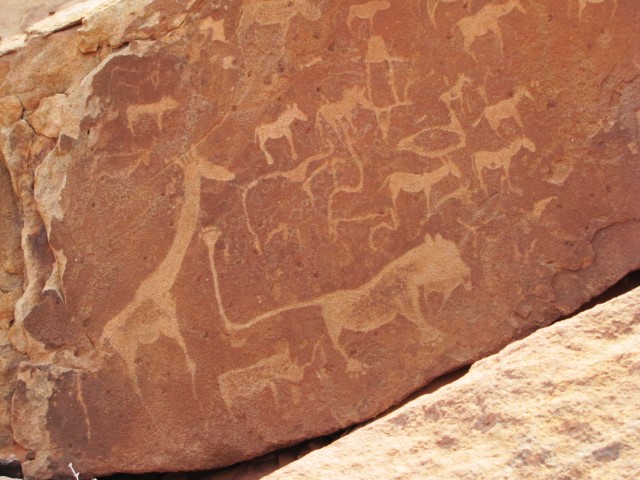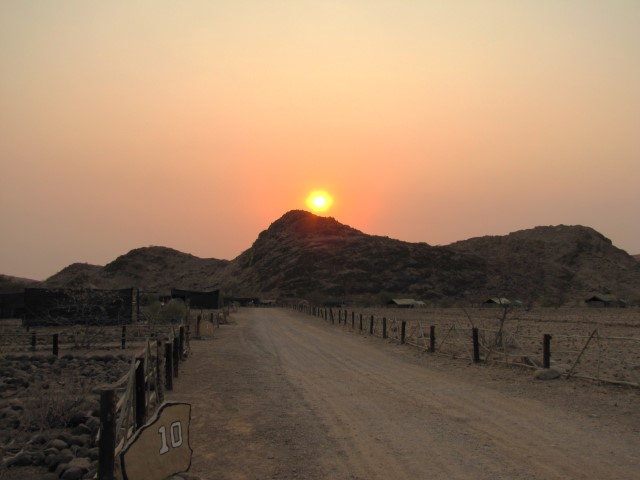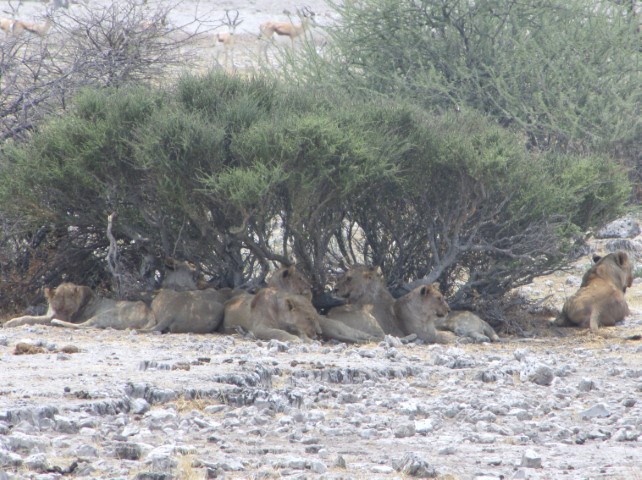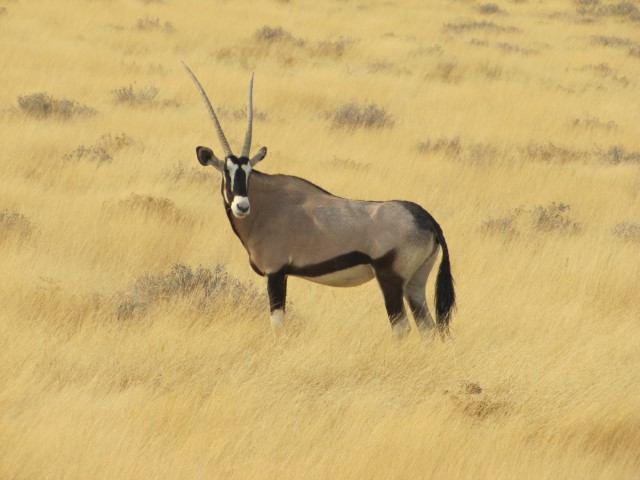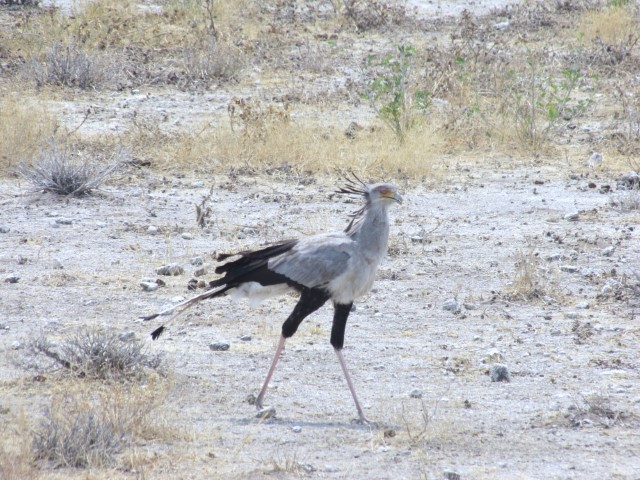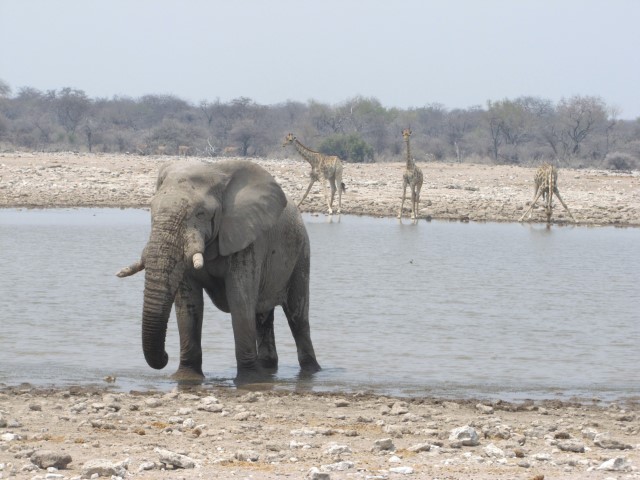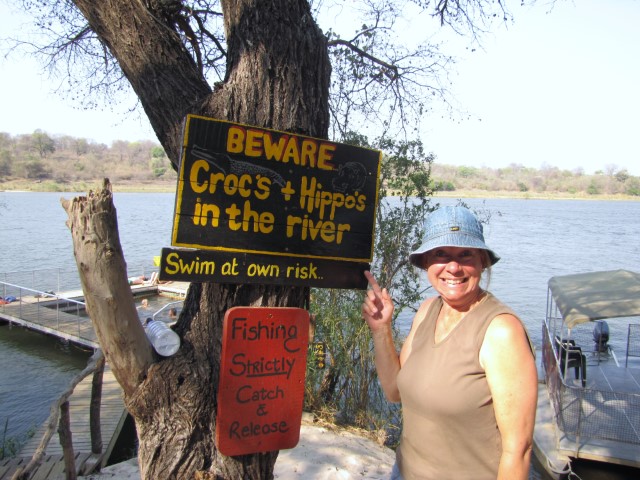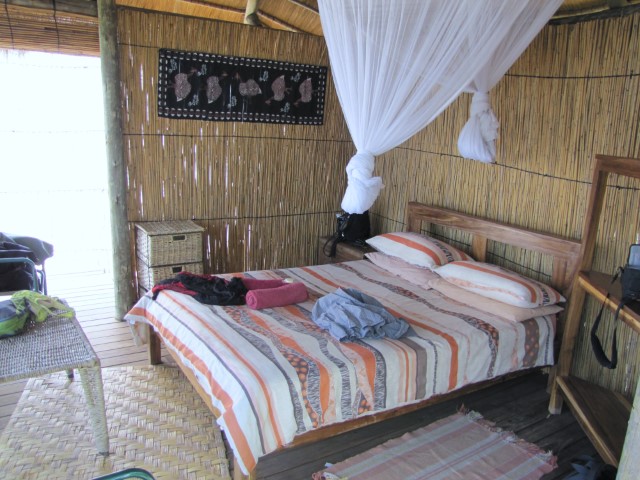Damaraland Region, Namibia (…continued)
Remote and rugged Camp Xaragu, Twyfelfontein is surrounded by steep, craggy hillsides. We pitch our tents on the sandy valley floor, under mesh-covered shelters which help keep tents cool when the weather is scorching.
Hung in the doorways of the ablution buildings are bamboo reeds that make a ‘tinkling’ wooden sound when you enter or exit. Shower units contain two shower heads per stall. The window of opportunity for a warmish shower is late afternoon when the water is heated by a wood fire behind each building.
We enjoy a delicious supper cooked in our camp kitchen’s Potjie Pot (Afrikaans, meaning small pot). The three-legged, lidded, cast iron pot sat atop hot coals that slowly simmered a savory stew. A veritable feast!
Ears perked and eyes wide in the darkness of my tent, I listen to the bark of baboons in the surrounding hillsides. Are these ticked-off-sounding primates preparing to raid our camp? One sets itself apart with a big bass bark. Do I foolishly have food in my tent? No…phew!
My middle-of-the-night concerns are somewhat put to rest the next morning when I learn the baboon ruckus was likely a very vocal family meeting, not a call to arms against the Homo sapiens squatting in their territory.
Our explorations in and around this area include viewing some of the over 2,500 primitive rock engravings at this Unesco World Heritage Site. Dating back to the early stone age, it’s not fully known whether the etchings are the work of the Indigenous Damara, or the San.
There is a feeling of excitement and anticipation around camp tonight. We are off to Etosha National Park tomorrow! I hit the tent early but not before almost colliding with a cow that comes trotting around the corner as I’m coming out of the loo. Along with the nightly baboon family council vocalizations (I never did see one), I hear a large herd of donkeys pass through camp in the middle of the night.
Etosha National Park, Namibia
Covering an area of over 22,000 sq km, Etosha ranks as one of the world’s greatest wildlife viewing areas.
“All the menageries in the world turned loose would not compare to the sight I saw that day.” G. McKeirnan, 1876
We prepare to enter the park through the Andersson (Okaukuejo) Gate. The motorbikes, which are not permitted in the park, are being stored here on the outskirts.
An open-air safari truck pulls into the parking lot to help accommodate the overflow of bikers. Hmm, overland truck or safari truck? Wishing to be released from the confines of the Beast, I climb aboard the safari truck and smugly snag a seat.
No sooner do we pass through the gates when a lion comes sauntering out of the bush. I grab for my camera…what, no camera?! In my haste to escape the Beast, I’ve left it onboard. Following the lion we see giraffes, elephants, birds, and hooved beasts galore, and I’m left to take snapshots only in my mind. Not so smug now, are you, Amy.
Our campsite is in a gated compound within the park. As darkness descends, I and another from our group head off to the wildlife water hole observation area to spend the evening watching Africa’s finest, who put on an amazing show.
The scene is already unfolding as we find a bench. Giraffes and a Black Rhinoceros are at the dimly lit water hole, centre stage. We curiously observe the giraffes as they attempt to drink but seem nervous to take a sip. The effort required to splay their long front legs to reach the water then quickly stand up, again and again, without quenching their thirst, is agonizing to watch. Soon, the reason for their hesitancy is clear. From the darkness, a lion’s not so distant roar causes the giraffes to gallop off, and the peach fuzz on the back of my neck to stand on end.
The Black Rhino now holds centre stage. The scene is so quiet you can hear her hooves crackle over the rocks as she moves around the water hole.
The lion then appears. But instead of approaching the water hole, she casually ambles towards the edge of the viewing area a short distance from where we are sitting. Suddenly, she snarls and takes a lunge at the wall and wire that separates humans from wildlife. Sounds of fright erupt from the darkness, a scurrying of feet, then people appear behind us whispering loudly and laughing nervously. I think I hear their hearts pounding too, but realize it’s just my own as I take in the scene that has just unfolded.
My heart rate eventually slows, the lion wanders away, ignoring the rhino, and the people return to their benches. Excitement over, the rest of the evening is a quiet observation of the wonders of African nature coming and going from this delightful nighttime stage.
At the end of another adventurous day of exploring, from atop a tall stone turret within the confines of camp, the continuous panorama of the park reveals itself as I walk the perimeter in peaceful solitude. Facing west, I witness the beginning of yet another stunning sunset, the fiery ball sinking into the clouds and setting them on fire. In the distance, a family of graceful giraffes seem to be taking in the end of another day as well, joining me to gaze out over the African plains.
On our way out of the park, we stop to stand on the Etosha Pan. This great white place of dry water is an immense, flat, saline desert that for a few days each year is converted by the seasonal rains into a shallow lagoon that teems with flamingos and pelicans. A strong wind whips up the salt that pelts our legs like sand, as our Captain explains that the winds are indicative of the rains that will soon be coming.
As we depart Etosha, I take in the untamed beauty of the bush, grasslands, and creatures that abound one last time, and reflect on how grateful I am to have had the opportunity to observe the plethora of diverse wildlife that call this park home.
Ngepi Camp, Divundu, Kavango, Caprivi Region, Namibia
Upon arrival and seeing a crowded campground, my fellow mother trucker (and travel mate extraordinaire) and I secure the last available Tree House on site.
We follow a sandy path and cross a wooden bridge to get to our tiny abode situated over the banks of the Okavango River. Not a tree house so much as an open concept, thatched roof hut on stilts, it is surrounded by trees and dense shoreline vegetation.
The central room contains a bed surrounded by bamboo walls. The side walls have open doorways, and the front wall overlooking the river consists of a simple bamboo blind that can be raised and lowered.
Surrounding the bedroom is a curved deck with no railing. Along one side is an outdoor shower, sink, and a toilet discreetly tucked out of site. We both agree how romantic our treehouse is, look at one another, unromantically, and crack up. We take turns lounging in the hammock and gaze out over the river. Warthogs and elephants can be seen with binoculars on the far shore as they approach the sandy edge for a drink.
As I wander around this funkily laid out camp, I find myself dangling my feet in the crocodile and hippopotamus filled waters of the river while sitting on the deck of a large, submerged cage that keeps guests safe. Some take a plunge in the cool murky depths.
In our special treat of a treehouse, with the blind open to the river and a sky full of twinkling stars, I’m eventually lulled to sleep to the sounds of hippos grazing along the banks below; grunting, honking, and calling to one another as they enter and exit the river.
We’re on the road again at 0600. We have a long day ahead and another border crossing. So far, we’ve traveled over 4,000 km and are nearing Zambia. Specifically, Livingstone, where my dear friends from Hawkestone, ON now reside, and I can’t wait to see them.
To be continued…

